In this article, you’ll learn how to craft a compelling value proposition. But before you do that you need to understand what creates value and how the different elements can be used.
Table of Contents
What Is A Value Proposition?
In simple terms, a value proposition answers the question of why a customer will buy your product compared to another. A value proposition succinctly expresses creates a strong first impression.
A value proposition is a clear statement of the tangible results a customer gets from using your products or services. It’s outcome focused and stresses the business value of your offering.
In this article, I’ll cover the value proposition from a number of different perspectives. A lot of people struggle with the value proposition so it’s worth taking time to understand what is value?
Smith and Wheeler (2002)[mfnSmith, S. and Wheeler, J. (2002) Managing the Customer Experience. FT-Prentice Hall. Harlow, UK.[/mfn] consider that designing what they refer to as a ‘branded customer experience’ is vital to delivering an effective value proposition. They also stress the importance of “developing a profound understanding of the customer’s experience”. The keyword is profound – they suggest that detailed research must determine the nature of value which will drive buying and loyalty behaviour.
JTBD Theory of value
People do not want a quarter-inch drill, they want a quarter-inch hole.
Theodore Levitt
Therefore, this theory focuses on the jobs-to-be-done by the potential customer. A jobs-to-be-done analysis allows switching the focus toward
- The “job” the customer is trying to get done. This is the unit of the analysis.
- Groups of people trying to get a job done define the market, rather than focusing on a product, or features of a product.
- Customers become job executors.
- This implies that you can group customers’ demographics and psychographics based on the struggles they experience in getting the job done.
A job is defined as:
A “job” is not a description of what the customer is doing, the solution they are using, or the steps they are taking to get a job done. Rather, the “job” statement embodies what the customer is ultimately trying to accomplish.
According to the jobs-to-be-done theory, which also informs the value proposition canvas, those jobs can be summarized as:
- Functional jobs
- Social jobs
- Emotional jobs
- Supporting jobs
Value proposition: tell me why I should buy from you
Kotler – in his book “Kotler on Marketing” – defines a value proposition as an answer to a key question that your potential customer has: “why should I buy from you?”
According to Kotler, a value proposition is critical to define the context in which the product needs to be positioned. More importantly to achieve a value proposition the business must go through four steps:
- Brand positioning
- Specific positioning
- Value positioning
- Total value positioning
In explaining brand positioning, Michael Porter highlights how a business should focus on achieving an advantage either as a product differentiator, a low-cost leader or a niche player.
According to Kotler, positioning opportunities can be classified as follows:
- Attribute positioning
- Benefit positioning
- Use/application positioning
- User positioning
- Computer positioning
- Category positioning
- Quality/price positioning
In choosing a value proposition, Kotler argues that buyers think in terms of “value for money: or what they get for what they pay.”
Why Use A Value Proposition?
It can be hard coming up with ideas around value and matching those to your customer segments. In fact, a poor value proposition is one of the contributing factors as to why startups fail. If you look at startup failure rates they are unbelievably high:
- According to an article in FastCompany, “Why Most Venture-Backed Companies Fail,” 75 per cent of venture-backed startups fail.
- After four years 56% of small businesses fail.
- 97% of seed or crowdfunded companies eventually dying or becoming “zombies.”
Many of these reasons link back to how the business model was designed. In particular, the lack of customer understanding or a poor value proposition.
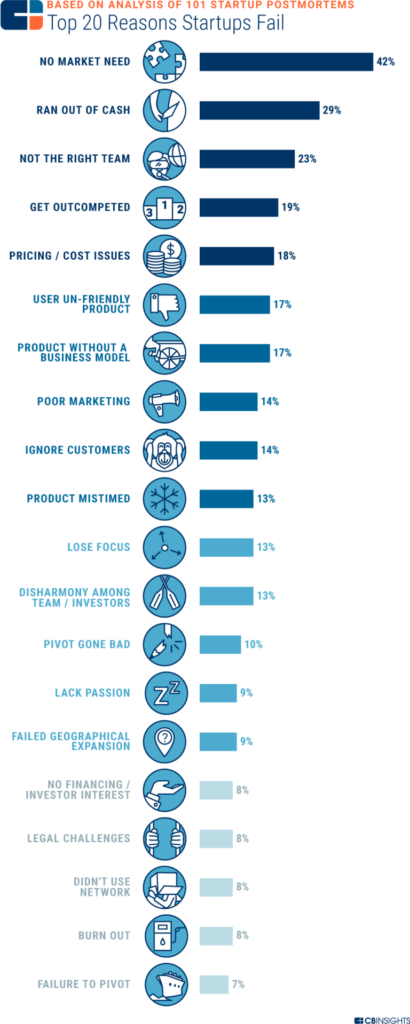
Most start-ups fail because they place too much emphasis on the ‘idea’. They fall in love with their idea more than they fall in love with understanding the customer.
Another reason is that the business model and value proposition wasn’t tested thoroughly.
Why is the value proposition so important? If you have a new product then the first hurdle is for your target customer to understand why they should buy it. Moreover, simply understand it and in seconds is a good start.
People make decisions in milliseconds and your value proposition has to be clearly understood and strong enough to convert potential customers.
As a result, and because of the high failure rates, more businesses are focused on developing early-stage ways to test both the product/service and the value proposition.
The bottom line is that customers aren’t interested in you or your products – they don’t spend hours of each day day-dreaming about your product or thinking about your business
The harsh reality is customers are only interested in themselves and you only fit it to their life’s if you are useful.
- what you can do for them that makes them feel better.
- how you make their lives easier.
- make them feel better about themselves.
If you’re going to communicate with customers, you need to first understand their preferences and requirements, then learn how to speak their language. This is the foundation of all marketing.
The Business Model Canvas Value Proposition
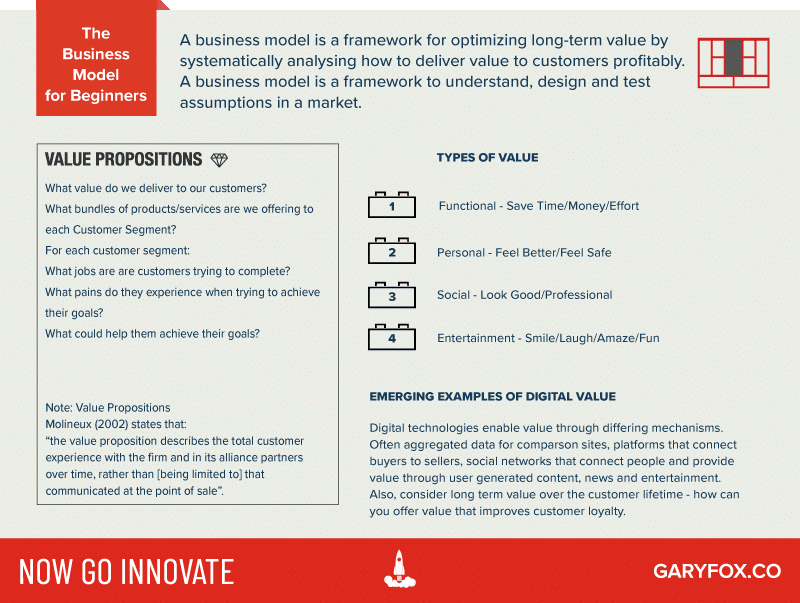
If you have several customers all seeking the same product for a different primary benefit, and you message all of them about the same benefit, you will not get traction, you will simply waste your time, energy and budget.
Value is contextual – what appeals to one set of customers might not appeal to another.
A person buying flowers for a wedding has a different set of needs and requirements compared to someone buying flowers for their partners to be romantic.
While taglines, slogans and positioning statements are important to your brand, they influence a customer’s decision to buy. A value proposition, however, is not a slogan, a tagline, or a positioning statement. This is a mistake that many people make.
What Is Value?
The Value Pyramid
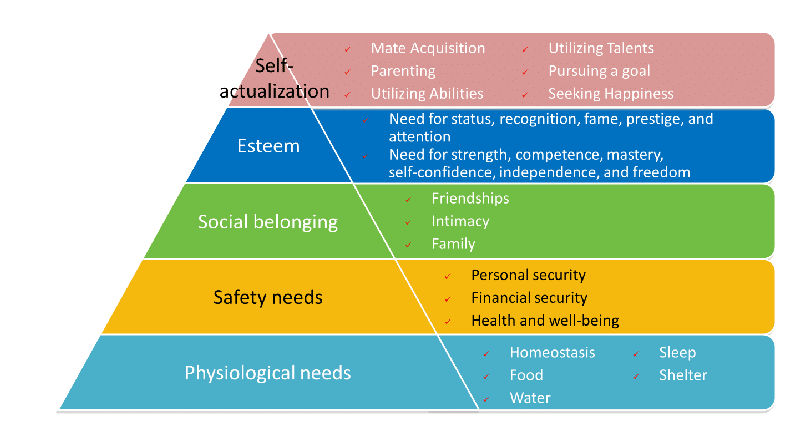
Maslow’s hierarchy of needs is a motivational theory in psychology comprising a five-tier model of human needs, often depicted as hierarchical levels within a pyramid.
I’ve included two visual diagrams that neatly summarize a hierarchy of value – one for B2C and one for B2B. If you are familiar with Maslow’s hierarchy of needs (image above) you will see many similarities of a value mapped to the different layers.
Broad Value Categories
- Performance – improve a task, process or an overall result e.g. sales.
- Risk reduction – reduce the level of uncertainty in making a decision or an investment e.g. money-back guarantee.
- Accessibility – provide access to otherwise expensive assets or experiences.
- Customization – provide a product or service that is tailored to an individual’s needs.
- Convenience – make it easier to do – quicker to get done.
- Connectivity – make it easy to connect buyers to sellers e.g. Musical talent to fans (Spotify).
- Save money – compare the market and hence find the best price e.g. hotel comparison sites.
- Social status – make me look good feel good – enhance how people see me.
- Design – make something unique and aesthetically appealing.
- Experiences – moments (either individual or shared) that enrich or enhance a person’s life.
While broad categories are useful I find that most people want specific examples to play as they design their business model. Using individual elements, and sensing how they fit in the hierarchy, makes the development of the value proposition much easier.
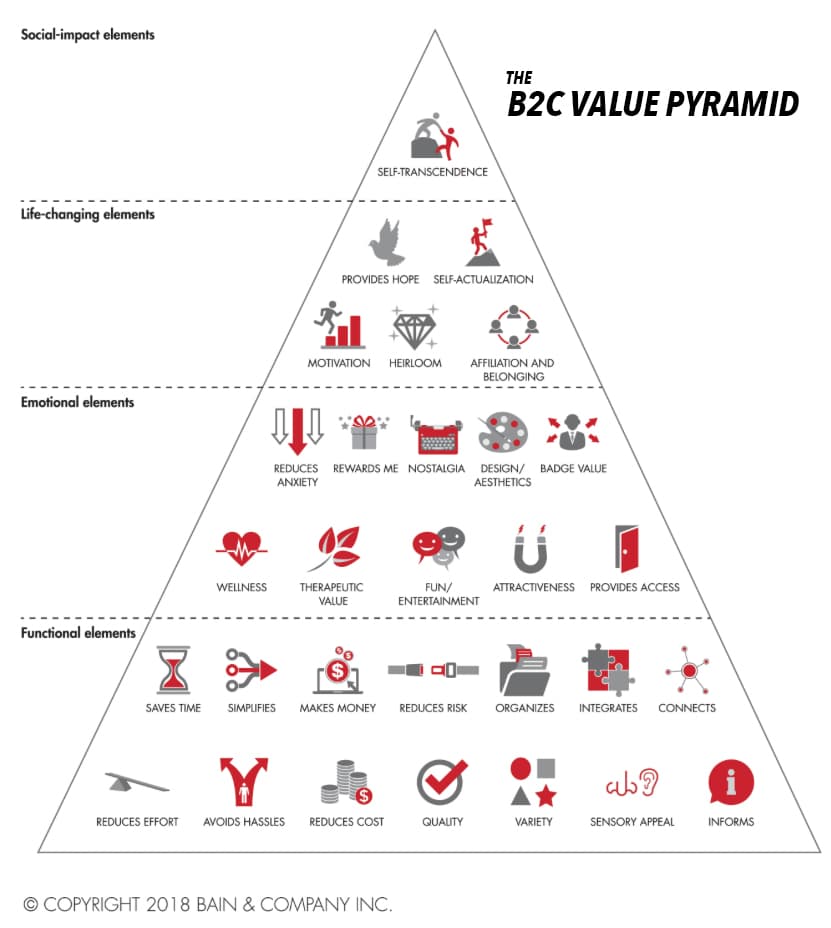
B2C Value Elements
Functional Elements
- Avoids Hassles
- Connects
- Informs
- Integrates
- Makes Money
- Organizes
- Quality
- Reduces Cost
- Reduces Effort
- Reduces Risk
- Saves Time
- Sensory Appeal
- Simplifies
- Variety
Emotional Elements
- Attractiveness
- Badge Value
- Design/Aesthetics
- Fun/Entertainment
- Nostalgia
- Provides Access
- Reduces Anxiety
- Rewards Me
- Therapeutic Value
- Wellness
Life-Changing Elements
- Affiliation and Belonging
- Heirloom
- Motivation
- Provides Hope
- Self-Actualization
Social Impact Elements
- Self-Transcendence
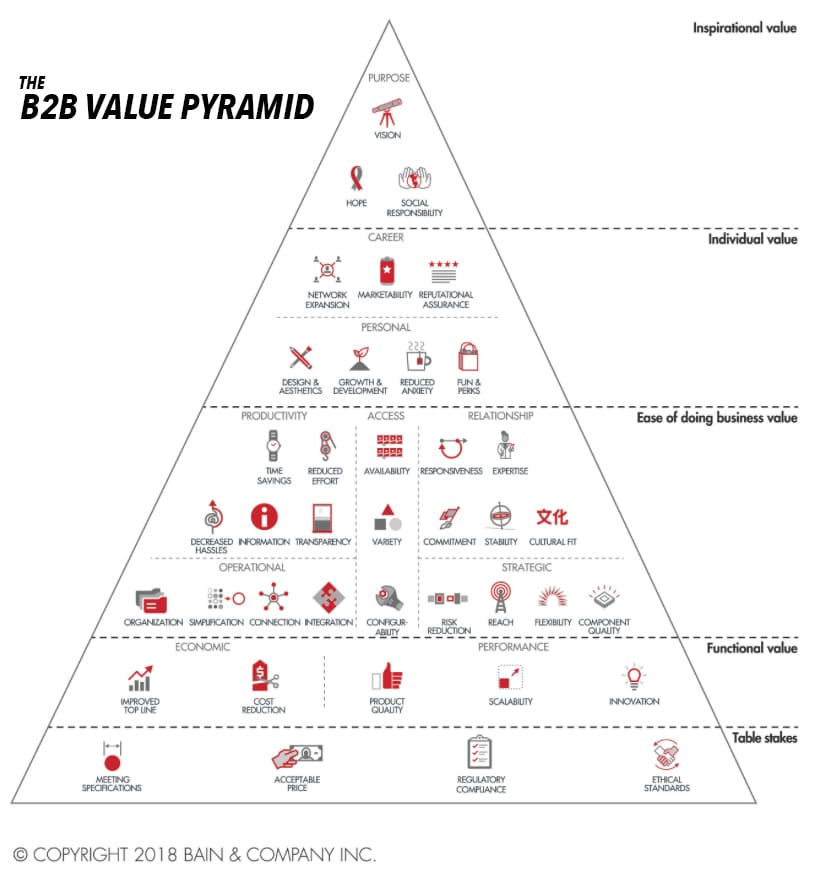
B2B Value Elements
Business to business buying is different in many ways to B2C. Often buying cycles are longer, products and services more complex, involve more people and are of a much higher value. For this reason, the principles and elements of value differ.
Table Stakes
- Acceptance Price
- Ethical Standards
- Meeting Specifications
- Regulatory Compliance
Functional Value
- Cost Reduction
- Improved Top Line
- Innovation
- Product Quality
- Scalablity
Ease of Doing Business Value
Strategic
- Component Quality
- Flexibility
- Reach
- Risk Reduction
Operational
- Connection
- Integration
- Organization
- Simplification
Access
- Availability
- Configuration
- Variety
Productivity
- Decreased Hassles
- Information
- Reduced Effort
- Time Savings
- Transparency
Relationship
- Commitment
- Cultural Fit
- Expertise
- Responsiveness
- Stability
Individual Level
- Design and Aesthetics
- Fun and Perks
- Growth and Development
- Marketability
- Network Expansion
- Reduced Anxiety
- Reputational Assurance
Inspirational Level
- Hope
- Social Responsibility
- Vision
In a nutshell, a great unique value proposition should have:
- Relevancy – explains how your products and services solve customer problems or how they improve the customer’s situation.
- Quantified value – should show the specific benefits customers will derive from your products and services.
- Unique differentiation – should show customers why they should buy from instead of your competitors.
Value Proposition Elements
Newness
Some value propositions are based on the newness or novelty factor they provide. This element usually comes into play for technology-intensive products and often fits early-adopters as a customer segment. As an example, the launches of new iPhones and the subsequent queues at stores have become an annual event.
Performance
Improving the performance of a product has led to many reinventions of products. Shampoos and facial treatments are a good example of how new ingredients give rise to new value propositions within the market. However, it is hard to compete on performance alone unless your product creates a substantial difference in the marketplace.
Customization
Consumers trends and technologies have converged to create a world where companies now are actively seeking new ways to personalization products and experiences.
In a report by Internet Retailing, 69% of consumers want to have a personalized experience, yet less than 50% of brands are actually delivering.
Nike lets its customers customize their shoes through NikeID on their website. A consumer can go online and create a completely original design with their preferred colour palette, placement, colour and size of the swoosh etc for their shoes. They can see what the end product will look like visually, play around with different permutations till they reach a result that suits their tastes and then order the final product when they are ready.
Getting the job done
When a product helps a consumer or business reach the end goal, its value proposition results from how it helped the customer to achieve their goal – or expressed differently get a job done.
Design
Most clothing labels rake in a higher price tag because of the superior design they have. Prada charges top dollar for something as simple as a T-shirt because of the strength of its designs.
Brand/ Status
Design and brand/status can be clustered together because their appeal is quite similar. Just as people will show loyalty to a brand because of its design, people will also show loyalty to a design because of the perceived status the brand name offers to the owner.
Price
Price alone is a dangerous proposition to rely on unless it is supported by other elements. As an example, there are many ‘no frills’ airlines like Southwest airlines. However, soon other airlines also replicated their offer and in fact, some companies created secondary brands in the market. Low price value propositions and strategies need to be supported by efficiency in operations and usually self-service customer relationships.
Cost Reduction
Products and services catered towards enhancing customer experience by reducing the cost a customer would ultimately incur cater to the cost reduction value proposition. Many price comparison sites open up transparency and easy access to pricing that otherwise would be hidden. In doing this they offer value by allowing customers to make savings on third party products or services.
However, if you are a third-party service this places a greater emphasis on using other variables to create a difference.
Risk Reduction
The less risk associated with purchasing a product or service, the more likely a customer is to buy it. Risk reduction is an important factor for both B2C and B2B customers and increases as a factor as the level of investment increases.
Accessibility
Another key ingredient for an effective and robust value proposition is making a previously inaccessible product or service available to a consumer segment. Innovative technologies and variations in business models have both led to offering accessibility to unserviced customers. NetJets is a wonderful example of providing accessibility.
How To Design Your Value Proposition
- Identify all the benefits your product offers.
- Describe what makes these benefits valuable.
- Identify your customer’s main problem.
- Connect this value to your buyer’s problem.
- Differentiate yourself as the preferred provider of this value.
An Introduction To The Value Proposition Canvas
There is a better way to think about market segmentation and new product innovation. The structure of a market, seen from the customers’ point of view, is very simple: They just need to get things done, as Ted Levitt said. When people find themselves needing to get a job done, they essentially hire products to do that job for them.
Clayton Christensen
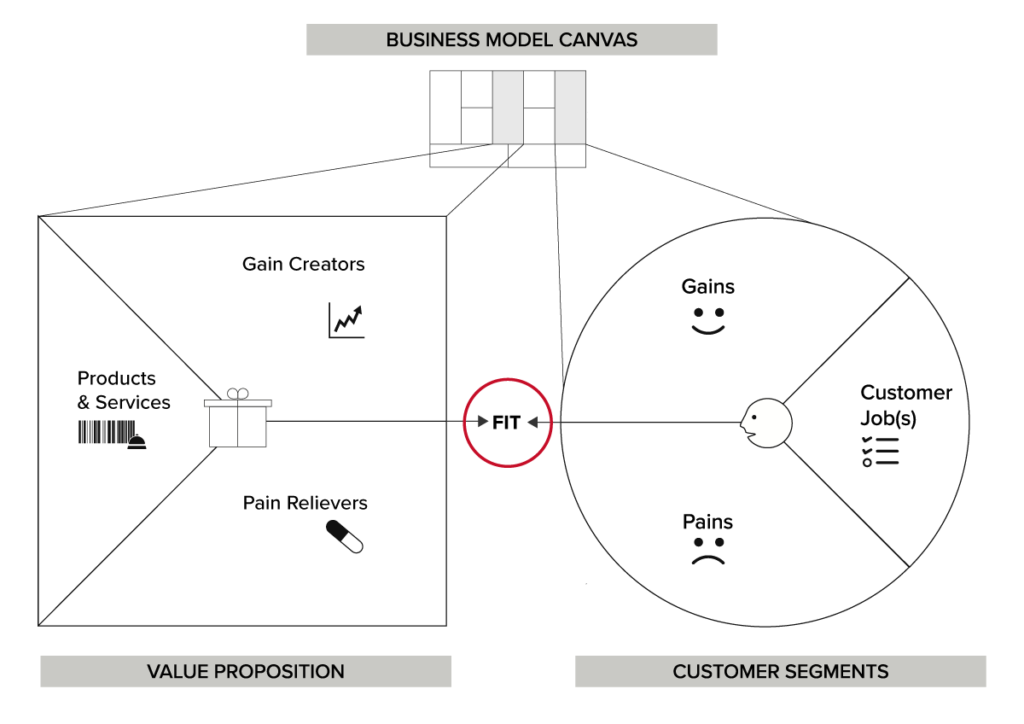
Having defined your customer segments and understood their goals you want to create a powerful and compelling value proposition.
The value proposition needs to ‘FIT’ with your customer segment and focus on your customer needs.
- Use ‘Pains’ to identify ‘Pain Relievers’
- Use ‘Gains’ to identify ‘Gain Creators’
How do you write a value Positioning statement?
- Identify all the benefits your product offers.
- Describe what makes these benefits valuable.
- Identify your customer’s main problem.
- Connect this value to your buyer’s problem.
- Differentiate yourself as the preferred provider of this value.
A Value statement is what’s important to your company, what it prioritizes, and how it conducts itself.
A Value Proposition is a statement that paints a clear picture of what your brand has to offer. It tells your potential customers:
- How your product or service solves/improves problems.
- What benefits customers can expect.
- Why customers should buy from you over your competitors.
Value Proposition Checklist
When you have created your value proposition check that you can answer these questions:
- Did you order your value proposition?
- Are you clear why your value proposition fits the hierarchy?
- Can you clearly state how you value proposition fits customers pains/gains?
- Does this proposition create a strong first impression?
- Does the proposition match what we know about this customer segment?
As celebrated advertising guru David Ogilvy pointed out:
The trouble with (conventional) market research is that people don’t think how they feel, they don’t say what they think and they don’t do what they say.
David Ogilvy
The point is that despite how well you craft your value proposition you still need to test it.
Outcome
After completing this section you will have developed your value propositions for each customer segment. You should also buy now have a much more detailed understanding of your customers and what motivates them.